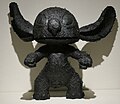Brett Graham | |
|---|---|
 Graham in 2008 | |
| Born | 1967 (age 57–58) Auckland, New Zealand |
| Education | University of Auckland (BFA, 1988), University of Hawaii at Manoa (MFA, 1990), University of Auckland (DocFA, 2003) |
| Known for | Sculpture |
| Website | brettgraham |
Brett Graham (born 1967) is a New Zealand sculptor who creates large scale artworks and installations that explore histories of imperialism and global indigenous issues. Graham lives and works in Waiuku on the southern shore of Manukau Harbour in Auckland, New Zealand.




